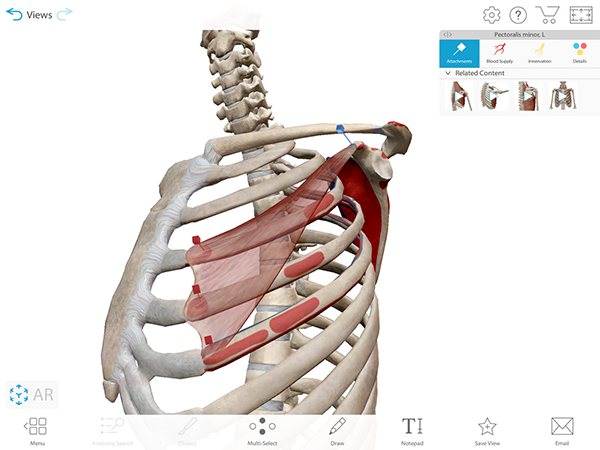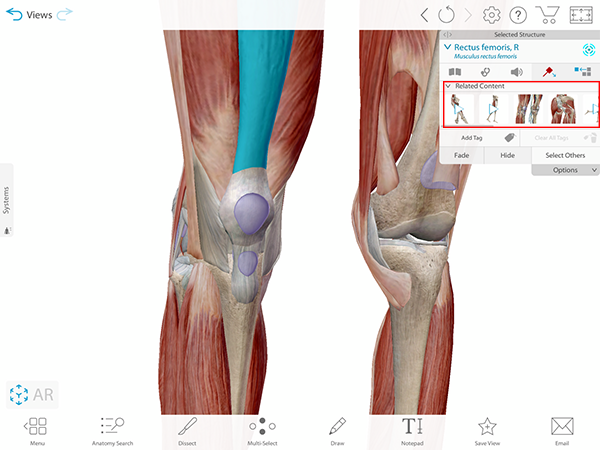Fall 2020 Student Survey Results: Three Things Students Love About Courseware
Posted on 1/13/21 by Laura Snider
The results are in! In early December 2020, we sent out a survey to students who had used Visible Body Courseware during the fall semester, and 798 of them responded.
As we’re all aware, online learning was more central to many students’ experience than ever during the past year. Of the students who responded to the Courseware survey, 66% were enrolled in a course that was 100% online, and 30% were enrolled in a hybrid course. Only 4% were enrolled in courses that were 100% in person. Therefore, virtually all the results below pertain to students who were at least some of the time physically away from lab and/or class.
The results of the survey showed that Visible Body makes learning fun and engaging, especially for visual learners. Overall, 91% of students said that Visible Body Courseware was helpful in keeping them engaged while studying on their own, with 65% of them saying it was “extremely” or “very” helpful. In addition, 88% of students would recommend Visible Body to other students who are studying anatomy and physiology, with 58% “strongly” agreeing they would do so.
When it comes to textbooks, 9 out of 10 students view Visible Body Courseware as either a great replacement for a textbook or a great companion to one. Want to learn more about using digital textbooks vs traditional ones? Check out this blog post. You can also watch (or read the summary of) this webinar given by Prof. Cindy Harley, in which she discusses the results of replacing a traditional A&P textbook with Visible Body’s apps.
Based on their responses to and comments on the survey, here are three specific aspects of Courseware that students liked best.
1. Mobile and web access
One of the main ways Courseware keeps students engaged both in the lab and at home is its accessibility on a wide range of devices. Since the Courseware platform itself is web-based, students can complete assignments and explore the web versions of Human Anatomy Atlas, Anatomy & Physiology, Physiology & Pathology, Muscle Premium, and Physiology Animations on any desktop or laptop that meets the system requirements. All they need to do is open a web browser, go to courseware.visiblebody.com, and log in.
But wait—there’s more! With a Courseware subscription, students can also download the mobile version of the apps to their phone or tablet for reference and studying on the go. (Here are the instructions for downloading the mobile apps!)
Here’s what one survey respondent had to say: “I loved that I could download the app to my phone and study while I was at work. [It’s] a great interactive app for hands-on learning people.”
2. Studying structures, especially muscles and bones, in 3D
Let’s face it: studying the body’s bones and muscles is no easy task, whether that means simply identifying each one or exploring details like landmarks, origin(s), insertion(s), blood supply, and innervation.
Fortunately for several of the students who left additional comments on the survey, manipulating 3D models helped them learn about bones and muscles in an interactive and fun way!
One student said, “This was my second time taking [an] anatomy and physiology course. I found that Visible Body was a HUGE help and really added to the learning experience. Having a 3D model accessible at home, and being able to manipulate that model and see all of the bones and muscles from different points of [view] was extremely helpful. Visible Body definitely made learning much more easy and enjoyable!”
Another student commented: “Thank you for such an easy, accessible, and interactive way to study anatomy! It was so helpful, especially for learning the bones.”
And it’s not just being able to see structures from any angle that makes Visible Body excellent for learning about the musculoskeletal system. In Human Anatomy Atlas, clicking or tapping a structure brings up an info box that can show you a wealth of important information. To see bone landmarks, simply select the bone and then click or tap the bony landmarks button in the info box (shown in the video below).
How to access detailed information on structures in Human Anatomy Atlas, one of the apps included with Courseware.
When you select a muscle, click or tap the pin icon to go to a view that shows muscle pins and paint for origins and insertions. From that view, you can add in the arteries that supply blood to the bone you’ve selected, as well as the nerves that make it move.
 The muscle details view in Human Anatomy Atlas.
The muscle details view in Human Anatomy Atlas.
If you want to see the movements a particular muscle performs, selecting that muscle in a view will also give you access to moving muscle action models through the Related Content section of the Info Box.
 The Related Content box in Human Anatomy Atlas.
The Related Content box in Human Anatomy Atlas.
Overall, 95% of students reported that learning anatomy through manipulating 3D models of anatomical structures is helpful, with 75% of them saying it is “extremely” or “very” helpful.
3. Bite-sized learning
In previous blog posts and videos, we’ve talked about how educators recommend breaking down content into bite-sized chunks, such as 10-minute videos instead of hour-long lectures, especially in online courses. Bite-sized learning is a principle we embrace here at Visible Body—our Anatomy & Physiology app is deliberately structured in short, manageable modules that allow students to learn at their own pace.
Anatomy & Physiology, one of Visible Body's best-selling apps, is also a component of Courseware!
These modules (which can include text, illustrations, 3D models, animations, and histology slides) can be assigned directly to students in Courseware when you create an assignment. Assignments can include any number of A&P modules—from a single section, to a whole chapter, to a whole unit. Want to use 3D gross anatomy, microanatomy, or pathology views, or maybe some CT or MRI scans? Check out this support article for more information about what kinds of content from each app can be used to create assignments.
The Fall 2020 survey results confirm that bite-sized learning is one of students’ favorite things about Courseware. In fact, 92% of respondents said that Visible Body Courseware helps them work through difficult concepts in bite-sized pieces, with 68% of them saying it is “extremely” or “very” helpful. Additionally, 92% of students found that learning physiological concepts and processes by watching short animations is helpful, with 65% of them saying it is “extremely” or “very” helpful.
The conclusion? Visible Body facilitates more efficient learning.
The combination of cross-device accessibility, mobile reference apps, 3D assets, and short learning modules made Courseware a big hit with students. Overall, 86% of students agree that studying with Visible Body is an efficient way to learn anatomy and physiology, with 51% “strongly” agreeing.
Want to know what educators thought about using Visible Body in their courses this Fall? Keep your eyes peeled for our Fall 2020 survey of instructors!
Be sure to subscribe to the Visible Body Blog for more anatomy awesomeness!
Are you an instructor? We have award-winning 3D products and resources for your anatomy and physiology course! Learn more here.



